One of the main reasons why people become preppers is that they want to be more self-reliant. While food, water, and defense are extremely important parts of being a prepper, being able to perform basic repairs and build things is important as well. Because of this, every prepper needs a comprehensive tool kit.
Below is a list of tools that every prepper needs. I have attempted to organize them into categories for the jobs they will be most useful for. However, some tools, such as pliers, are useful for many types of jobs and could logically fit into several categories. However, just for simplicity’s sake, I will only mention each tool once.
Training and Education
Unfortunately, accidents are fairly common when people work on DIY projects or on a job site. Most of them are caused by carelessness, lack of proper training, or both. Because of this, it is important to educate yourself on how to use tools the right way and complete jobs safely.
There are many ways to gain this information. I learned by working on projects with my dad and watching Youtube videos. The Essential Craftsman is one of my favorite channels on the web. He has a ton of useful tips and information that cover the use of various types of tools. Click here to visit The Essential Craftsman Youtube Channel.
Taking shop classes while you are in high school or at a local community college are great ways to get training. For more specialized activities, such as blacksmithing, local clubs are valuable sources of information, and you may even be able to find a mentor to take you under their wing.
Related: How to Get Good Tools Cheap
Personal Protective Equipment
The most important items that a prepper should have in their tool kit is personal protective equipment. Tools, especially power saws, can result in serious injury if not used properly. However, even the most careful people make mistakes. Using the equipment below should be standard procedure when working with tools. Some jobs may require additional protective equipment, but the items below will give you a good start.
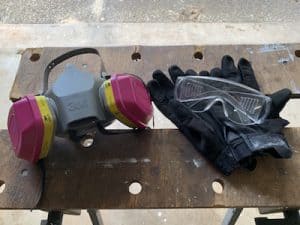
Eye Protection
Eye protection comes in a couple of different forms. The first and most obvious is goggles or glasses. These work well when you are using power tools and hammers. Make sure that you get goggles or glasses that don’t leave much of a gap between them and your face. Small objects can easily go between the glasses and your face and go straight into your eye.
Face masks are another form of eye protection. These will protect your entire face, not just your eyes. They are especially useful when working with chemicals.
Ear Protection
Many tools, especially power saws, are very loud. They are so loud that using them for prolonged periods of time without ear protection can result in permanent hearing loss. To avoid this, be sure to use earplugs or earmuffs while working with loud tools.
Dust Mask or Respirator
Dust and fumes that result from DIY projects can be hazardous to your health. Dust masks, like the N95 masks you can buy almost any hardware store, do okay protecting you from breathing in dust particles. However, when using paints and other chemicals that produce strong fumes, a prepper needs a respirator in their tool kit.
I use a half-face respirator from 3M. It looks kind of like a gas mask. My particular mask and others like it have replaceable filters that can prevent you from breathing in dust as well as harmful fumes from paints and solvents. What a respirator will protect you from will depend on the mask design and the filters it uses. Be sure to research the respirator that you buy to make sure it will protect you from everything you need it to.
Gloves
When doing projects, your hands are what allow you to do most of the work. They are also some of the most likely parts of your body to get injured. Wearing gloves can prevent blisters and cuts as well as reduce the damage caused by certain accidents.
Other Gear
Be sure to own and use any personal protective gear for any specialized activities you are doing. For example, when welding, you will need a special mask and gloves among other things. When using a chainsaw, wearing chaps protects your legs.
Carpentry Tools
Carpentry, in its most basic definition, is the ability to build things using tools. Framing a house, building a kitchen table, and hanging cabinets on the wall are all examples of carpentry. Every prepper should have the following carpentry tools in their tool kit.

Claw Hammer:
A 16-ounce claw hammer is a good hammer for general use. It is the jack-of-all-trades of hammers. The claw design will allow you to drive and pull nails. A hammer of this weight will allow you to do light framing but not be overkill for smaller jobs like hanging pictures.
If you are going to do a lot of framing (building a shed or house) or demos/remodels, you will need something a little more substantial. For jobs like this, a 22-ounce framing hammer with a rip claw would be a good addition to your tool kit. Estwing Hammers are a popular choice. You can find one by clicking here.
A hammer of this size will pack a big punch and the straight rip claw will help you tear out old drywall. Good framing hammers will have a magnetic nail set and are available with either smooth or checkered faces.
Tape Measure (25 ft)
A 25-ft tape measure will be sufficient for most building projects. Good tape measures have easy to read markings and long standout. Standout refers to how far a tape measure can be extended without falling.
Speed Square
A speed square is a triangular-shaped solid piece of metal or plastic. It is most commonly used to mark straight lines for crosscuts on dimensional lumber, such as 2×4’s. They can also be used to measure short distances and determine angles. The Swanson Speed Square is the most popular version, although I like mine produced by Empire as well.
2-Foot Level
To have a well-rounded tool kit, you will need a couple of levels. A 2-foot level is large enough to be useful on door frames but no so large that it is cumbersome to handle.
Torpedo Level
The next level that you will need is a torpedo level. Torpedo levels are small levels that can fit inside a tool belt. They are useful to have so you can check your work without having to hunt down your larger level.
Chalk Line
If you need to make long cuts, like when ripping plywood, few tools work better to mark lines than a good chalk line. To make sure that your line is straight and square, mark your measurement on both sides of the board. Set the chalk line to run through both marks, pull the line tight, lift it, and then snap it.
Tool Belt
One important tool that many people overlook is a good tool belt. When I first started doing projects, I overlooked them as well. However, a tool belt will allow you to work more efficiently and safer. The ones made by Occidental Leather, like this one, are some of the best. To learn what to look for in a tool belt and how to set one up, check out my article, Tool Belt Setup.
Screwdriver Set
Another important addition to any tool kit is a screwdriver set. Be sure to get a set that includes flathead, Phillips, Torx, and Allen drivers or bits. One-piece screwdrivers are durable, but they take up a lot of space. Magnetic bit screwdriver sets are incredibly versatile, but they aren’t as durable as one-piece screwdrivers.
For my needs, I have one-piece versions of the screwdrivers that I use most often, mainly Phillips drivers. I use magnetic bit sets for less commonly-used fasteners, such as Torx head screws. The bottom line is that it is handy to have both types.
Needle Nose Pliers
The next tool that should be included in your tool kit is a set of needle-nose pliers. They will help you grab onto small objects, bend wires, and reach down and grab items that are slightly out of reach.
Every prepper should have several sizes of needle-nose pliers in their tool kit. Small ones work well to get into tight spaces, while larger ones can give you holding power and help you reach into deeper spots.
Slip Joint Pliers
Slip joint pliers are another tool that you need in your tool kit. These are one of the most common types of pliers and also one of the most useful. Slip joint pliers get their name from the adjustable joint where the two halves of the pliers are joined together. This feature allows you to adjust the pliers to suit the size of the object you are working with.
Locking Pliers
Locking pliers, also commonly referred to as “Vise Grips”, open and close like regular pliers, but also feature a locking mechanism to really clamp down on objects. Locking pliers are adjustable so that you can clamp onto objects of different sizes. Being able to control how tightly they lock onto an object is another advantage of using this type of pliers.
*Hint: Look for locking pliers that feature adjustment knobs that can accept Allen wrenches. Also, Milwaukee produces locking pliers with adjustment knobs that can accept screwdrivers. Both of these features will allow you to use tools to reduce tension before attempting to unlock the pliers. They will also allow you to tighten the locking pliers after you clamp them onto an object.
Adjustable Crescent Wrenches
An adjustable crescent wrench is one of the most versatile tools you can own. They are useful for all sorts of jobs, including plumbing, mechanics work, and small jobs around the house. I recommend getting at least two adjustable wrenches. The first is an 8-inch wrench, and the other is a 12-inch wrench.
Hacksaw
Hacksaws are mainly used to cut through metal and plastic. Try to get one with a metal frame along with appropriately-sized replacement blades. You may also want to consider getting a miniature hacksaw as well for working in tight spots.

Hand Saw
Hand saws are mid-size non-powered saws that make cross cuts through wood. When selecting one, avoid those that are shorter than 20 inches. Having a longer saw allows the saw to cut more in each pass, making them easier to use.
Rubber Mallet
There are times when you need to give something a good whack, but using a metal hammer could damage what you are working on. For jobs such as these, a two-pound rubber mallet is extremely useful.
Clamps (Various Types)
When building things and doing repairs, you will sometimes wish you had more than two hands. Clamps help you out by holding objects while you are working on them or holding multiple objects while you assemble them. Below are some types of clamps you will want to include in your tool kit.
- C Clamps
- Bar Clamps
- Locking Clamps
- Spring Clamps
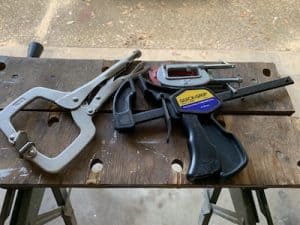
These are just a few of the clamps that I use when doing projects.
Cordless Drill
If you don’t have any power tools, the first thing you need to get is a cordless drill. They can help you with small tasks, like hanging pictures and larger jobs like building a deck or boarding up windows. Buying a set that contains both a cordless drill and an impact driver is a smart move. This one by Milwaukee is an excellent choice.
Impact Driver
An impact driver is similar to a drill, but it is specifically designed to drive screws, lag bolts and other fasteners. Impact drivers reduce strain on the user and are far less likely to strip a screw head than a drill.
Circular Saw
If you have a good circular saw, you can make cuts in plywood, dimensional lumber (like 2×4’s), and even sheet metal (with the right blade). Circular saws are essential tools for most job sites.
Extension Cords
If you use power tools, you will need extension cords. Get various lengths to suit different jobs. Also, be sure that you get cords that are the proper gauge or thickness. Thin cords will not be able to handle the current needed to power some tools and are safety hazards.
Portable Work Bench
Even if you have a full-size workbench at home, portable workbenches are important items to keep around. They allow you to set up shop in remote locations and give you additional work stations if necessary at home.
Demolition Tools
The next category of tools that a prepper should have in their tool kit is demolition tools. These work well to tear things apart (like when remodeling) and in extreme cases may be used as rescue tools if nothing else is available.
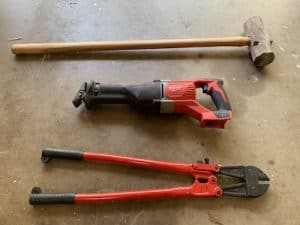
Crowbar
Everyone needs a good crowbar. The right one will allow you to pull nails, tear down pallets, and do many other jobs. Although they come in many shapes and sizes, a 24-inch wrecking bar is a good all-around choice. It will do a good job pulling nails and is long enough to give you the leverage you need when prying.
If you are doing trim work and plan on using your baseboards again, a wrecking bar will do just that. It will wreck your lumber. Instead, use a moulding pry bar. It features a thin and wide head that is perfect for getting under trim.
Sledgehammer
Few handheld tools will tear something apart faster than a sledgehammer. Sledgehammers can help you break apart walls and even concrete. I prefer a 10-pound sledgehammer, as it is manageable to use but still highly destructive.
Bolt Cutters
Losing the key to a padlock can be really annoying. Especially if you didn’t discover that it was missing until you need it. In situations such as this, a good set of bolt cutters can be a lifesaver. An 18-inch set of bolt cutters should be sufficient for most common tasks, such as cutting through padlocks and small to medium chains.
Reciprocating Saw
A reciprocating saw is one of the most useful tools that you can own. You can use it to do demolition work and work around the yard. They have even been used by firemen to rescue people trapped in vehicles. Thanks to the wide variety of blade options available for reciprocating saws, you can use them to cut through many types of material.
Plumbing Tools
If you are a homeowner, you know that plumbing issues are some of the most annoying problems on the planet. Clogged and running toilets and slow drains can make a stressful day even worse. In addition, calling a plumber every time that you have an issue can get expensive fast. Because of this, every prepper needs to have the following plumbing tools in their tool kit.
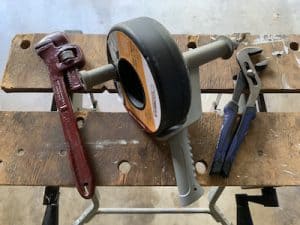
Channel Lock Pliers
Tongue and groove pliers, more commonly known as “channel locks”, are something you will find in every plumbing tool kit. They are excellent if you need to hold or turn an odd-shaped object as well as more common fasteners like nuts and bolts.
Pipe Wrench
A pipe wrench, also known as a monkey wrench is the best tool to use when you need to turn or hold round items, like threaded pipes and fittings. A knob on the side of the tool adjusts the jaws to the needed size.
On a side note, pipe wrenches are also some of the most dangerous tools in existence. The number of party guests killed by them during games of Clue is beyond comprehension…
1/4 Inch Drain Auger
Sometimes plunging a clog isn’t enough. When dealing with clogs in sinks, tubs, and other drains, a 1/4 inch drain auger (25-foot length) may save you an expensive plumbing bill. For more instructions on how to use one, click here to check out my article, How to Clear a Shower Clog. The information found in the article is applicable when using a drain auger to clear other drains as well.
3/8 Inch Drain Auger
When dealing with clogs in larger pipes, a 3/8-inch drain auger will do better than a 1/4 inch one. Just be careful not to force any drain auger, especially a larger one such as this into a pipe. Doing so could get it stuck, which would result in a very expensive plumber’s bill.
If you have the money, power drain augers are much easier to use than a manual one. I was having a really hard time clearing a clogged drain using a 3/8 inch auger like what is described above. I borrowed my dad’s power auger, and I had the clog cleared and the auger cable out of the pipe in less than 30 minutes. However, as with any of the tools on this list, be sure you research how to properly use it.
Toilet Auger
Toilets, due to their porcelain design, will get damaged if you use a regular auger when attempting to clear a clog. Working with extreme toilet clogs requires the use of a specialized toilet auger that will clear the clog and reduce the chance of the toilet becoming damaged.
Sink Plunger
When making your tool kit, you need to have at least two plungers. The first, a sink plunger, is probably what you are picturing in your mind right now. It has a handle with a simple rubber cup attached to the end. These work well to plunge sinks and tubs.
Toilet Plunger
The second type of plunger you will need is a toilet plunger. Toilet plungers differ from sink plungers in that they have an additional rubber flange connected to the bottom of the cup. This allows them to get a better seal inside the toilet, making it easier to clear toilet clogs. (Having a dedicated toilet plunger also prevents you from having to use the same plunger in your toilet and sink, which is gross.)
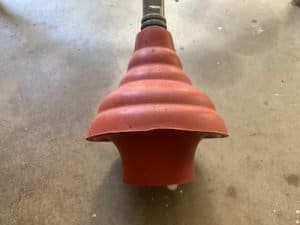
Basin Wrench
If you ever have to work under a sink, you will be glad that you had a basin wrench. Basin wrenches allow you to turn fasteners in tight spaces, such as when you are working underneath a sink with your head stuck inside the cabinets.
T-Handle Shutoff Tool
Before you do certain plumbing jobs, you will need to shut off the water leading to the house. Also, being able to shut off your water quickly in an emergency, such as a busted pipe, may prevent thousands of dollars of water damage. A T-handle shutoff tool is what you need to turn off your water at your meter box in situations such as these.
Electrical Tools
Every prepper needs to have a collection of electricians tools in their tool kit. These will allow you to fix and install lights and switches and perform many other jobs as well. If you have a solar power system, these tools will be even more necessary.
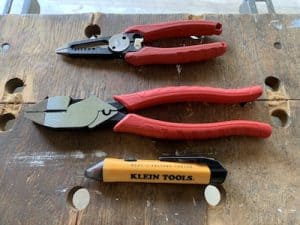
Non-Contact Voltage Detector
When working with electricity, you have to always put safety first. After you take the necessary safety precautions, such as turning off breakers, you have to double-check to make sure the electricity is really off where you are working. The perfect tool for this is a non-contact voltage detector.
Non-Contact Voltage Detectors (NCVT’s) are available in different types. Some will only detect alternating current (AC), while others will only detect direct current (DC). AC current is what is used inside homes, while DC power is used mainly for battery-powered devices and solar power systems. Since preppers may need to work with both types of current, they will need a voltage detector that can pick up both AC and DC currents.
GFCI Receptacle Tester
Have you ever had a lamp that randomly quick working one day but works fine after you plug it into a different outlet? If so, there is probably a problem with the plug. In cases such as this, a GFCI receptacle tester would be helpful to have on-hand. It will detect problems in most common plugs and give you an idea of what is going on.
Multimeter
A multimeter is an electronic tool that can perform several types of readings. It can measure current, voltage, and resistance.
Linesman’s Pliers
When cutting thick wires and cables, a good set of linesman’s pliers is indispensable. To get the most of your money, when selecting your linesman’s pliers, pick up a pair that has a built-in crimper.
Also, be sure to buy a larger set of linesman’s pliers. This will give you greater leverage while cutting and help prevent your hand from getting pinched while using them. Many cheap linesman’s pliers are too short, resulting in your hand being too close to the pivot.
Wire Strippers
When making electrical repairs, you will need to strip wires to connect them to terminals or each other. Wire strippers make this easy and fast. They can also cut small to medium wires, and some can even bend wire and cut common electrical screws to the proper length.
Mechanic’s Tools
Another category of tools that every prepper needs to include in their tool kit is mechanics tools. These will allow you to work on cars, trucks, tractors, and other types of motor vehicles.

Wrench Sets
When selecting a wrench set, make sure to get one that has both metric and SAE sizes. Doing so will ensure that you have the right wrench for the job and reduce the chance of rounding a nut or bolt. Wrenches are a must-have when removing fasteners from tight spaces.
Socket and Ratchet Set
Ratchets and sockets allow you to quickly remove fasteners from vehicles and other structures. They come in 1/4, 3/8, and 1/2 inch drive sizes. Although it is good to have all three, a 3/8 inch drive set can handle most jobs. If you can only add one set to your prepper tool kit, make it a 3/8-inch drive set. As with wrenches, make sure you have sockets in both SAE and Metric sizes.
Magnetic Pickup Tool
If you spend any time working on cars or other types of vehicles, you will eventually drop a small metal part into a deep, dark abyss. When you do this, the best way to retrieve the part is to use a magnetic pickup tool. These are cheap, and since they collapse down, they don’t take up much room in your toolbox.
Code Reader
I always have a sense of dread whenever that stupid check engine light comes on. However, having a code reader allows you to quickly figure out why the light is on without having to guess.
Even if you don’t have the ability to fix the problem yourself, a code reader can still be useful. If you have a general idea of what the problem is, you are more likely to know if someone is taking advantage of you when pricing a job.
Floor Jack
When changing tires and performing other work on vehicles, you will need to raise it up with a floor jack. When selecting a floor jack, be sure to get one with a weight capacity that can handle all of your vehicles.
Jack Stands
If you have to crawl underneath a vehicle that you have just raised with a jack, don’t even think about going down there until you have a good set of jack stands. Jack stands support the weight of the vehicle in case the jack fails. Like your floor jack, be sure to get a set that will support the weight of any vehicle you own.
Air Compressor
If you own a car, you can count on your low tire pressure light coming on sooner or later. Having an air compressor will allow you to top off your tires without having to go to a gas station. Air compressors are also incredibly versatile. They can power numerous tools such as impact wrenches, nail guns, and even paint sprayers.
It is also wise to keep a 12-volt inflator in your vehicles. These are small air compressors that plug into the cigarette lighter in your car. They can top off the air in tires and may be able to inflate other items such as basketballs.
Siphon Pump
A siphon pump is a good item to include in your prepper tool kit. They transfer liquids from one container to another. I have used mine to remove old gas from a lawnmower, although their uses go far beyond that.
Related: How to Fix a Lawnmower that Won’t Start
Stationary Tools
If you have space, stationary tools can greatly increase your precision and efficiency. Due to their usefulness, every prepper should include as many of them as possible into their tool kit.
Table Saw
A table saw is one of the most versatile power tools that you can own. Unfortunately, they can also take up a ton of space. My grandfather had a huge “cabinet saw” that was capable of doing almost anything you could need. Unfortunately, I didn’t have room for it in my garage.
To solve this problem, power tool companies offer smaller “job site” table saws. They are small enough to fit on a sturdy tabletop but are still capable of making long rip cuts in sheet materials, like plywood. You can even buy portable stands for them to be used wherever you need them.
Although table saws are incredibly useful, they are also some of the most dangerous power tools. Many people have lost limbs through accidents or improper use. Also, kickback can send materials flying back at you. In extreme cases, people have been impaled by a board they were trying to cut. Be sure you get push sticks and get plenty of instruction before you use a table saw or any other tool you are unfamiliar with.
Miter Saw
My favorite stationary power tool is my 10-inch sliding miter saw. Miter saws are primarily designed to do extremely accurate crosscuts in dimensional lumber or trim. They come in several sizes, but I recommend one with a 10-inch or 12-inch blade that has a sliding feature. These features will allow you to cut through wider and thicker boards in one pass. For example, my Ryobi 10-inch sliding miter saw can cut through a 4×4 post or a 2×12 in one pass.
Other good features to look for in miter saws include a dual bevel and shadow kerf line. A dual bevel will make angled cuts easier to manage. A shadow kerf line will allow you to see precisely where the saw is going to cut and how much wood the saw blade will eat away. Shadow kerf lines are also more accurate than lasers.

Bench Grinder
A bench grinder is a great addition to a prepper tool kit because of the wide variety of jobs it can do. Depending on the wheels that you have installed they can clean, polish, sharpen, and shape metal.
Bench Vise
A bench vise is an essential tool for numerous jobs. It is a helpful third hand that holds a workpiece while you do the work you need to do, whether you are cutting, disassembling, or refinishing. If equipped with removable soft jaws, you can use them to hold more delicate items as long as you don’t overtighten the jaws.
If you don’t have somewhere that you can permanently attach a vise to, you can attach it to a scrap piece of lumber, such as a 2×8, and secure the board to a table or portable workbench. While this won’t be as sturdy and secure as a permanent set up, you will still be able to get a lot of good use out of your vise.
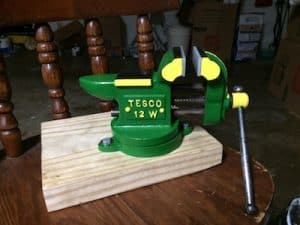
Metal-Working Tools
Being able to produce and manipulate different types of metals has allowed mankind to evolve its technology from sharpened rocks and sticks to rockets capable of sending probes into deep space.
Being able to weld, fabricate, and do blacksmithing will allow you to create and repair tools and equipment in ways that would be impossible otherwise. Although this tool list could be its own separate article, here are some of the basic metalworking tools a prepper may need in their tool kit.
Anvil
Anvils are good for more than just dropping on cartoon coyotes. They are indispensable when hammering metal into shape. They come in several shapes and sizes, and a good one will probably last you your entire lifetime. My anvil belonged to my great-grandfather and is probably well over 100 years old.

Blacksmith’s Hammer
While an anvil is the solid base on which you will do various types of metalworking, you will need one or more blacksmith’s hammers to pound your workpieces into shape.
Welding Gloves
Metalworking involves more intense heat than any other type of work. Because of this, you will need very thick and durable gloves to protect your hands from that heat and sharp jagged edges.
Forge
If you do any blacksmithing work, you will need a forge to heat the metal to the proper temperature. The only way to reach such high temperatures is by using a forge. You can buy them premade or make your own out of concrete blocks and other items.
Welder
Although they are energy hogs, welders are important tools for preppers to have and know how to use. If you are in a situation where you must repair a vehicle or other important piece of equipment, many times a welder is the only thing that will get the job done. Just be sure that you have a way to power it during a grid-down situation.
Welding Masks
Welding produces incredibly bright sparks. They are so bright that they can blind someone who looks at them without proper protection. Welding masks shield your eyes from the intense brightness and protect your face from errant sparks.
Welding Jacket
While a welding mask will protect your face and eyes, a welding jacket will protect your arms and the rest of your upper body. They are also flame-resistant, so you have less of a chance of turning into the human torch while wearing one.
Welding Clamps
Since welding operations require precision, you need to make sure that your workpieces don’t move while you are working on them. Welding clamps give you the extra sets of hands that you need to do a good job.
Angle Grinder
Angle grinders are incredibly versatile tools that can cut, shape, clean, and polish metal. If equipped with the correct cutting wheel, they can even cut concrete.
Cutting Torch
Cutting torches use extreme heat to produce precise cuts in metal. If using one, you will need plenty of fuel and the proper safety gear.
Land Management Tools
In an emergency situation, especially one that is long-term, you will need to work outside. While most people think of land management tools for gardening, they are also helpful in other situations. They can help clear paths, prepare the land for structures (fences, etc.), as well as reduce flooding and other environmental hazards.
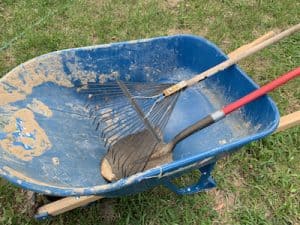
Shovel
Although this is listed as one item, every prepper should have several shovels in their tool kit. The kinds of shovels that you will need will depend on the climate and terrain where you live as well as the work that you will be doing. The most common type of shovel is a pointed digging shovel. However, post hole diggers and square shovels come in handy for certain jobs. If you live in an area that experiences frequent snowfall, a snow shovel is a must.
Bow Rake
A bow rake consists of a long handle and solid metal tines at the end. They are good for breaking up compacted soil. They also make spreading soil and fertilizer as well as leveling areas much easier.
Leaf Rake
A leaf rake is something that almost every suburban homeowner has in their garage. They are most commonly used to clean leaves and pine needles from yards, but they can also collect and spread hay and grass.
Wheelbarrow
If you have to move soil, rocks, or other heavy items a wheelbarrow is a must-have item for every prepper to have in their tool kit. I prefer one with a metal tray, although metal will rust when the paint wears off. Wheelbarrows with two tires up front are more stable than those with just one, but they may be a little less maneuverable.
Chainsaw
One of the most important land maintenance tools for a prepper to own is a chainsaw. A good chainsaw will help you gather firewood, clear downed trees from roads, and perform a host of other tasks.
Chainsaws come in a variety of sizes, but most preppers would need one with a 16 to 20-inch bar. Smaller chainsaws are easier to handle, but chainsaws with longer bars can cut through thicker material.
While electric chainsaws are available, most preppers should consider one that is gas-powered. Electric ones are much easier to start but are usually limited in size and power. When using a gas-powered chainsaw, be sure to stock up on fuel and oil and mix it properly. Also educate yourself on how to perform basic maintenance and repairs on your chainsaw, because they do tend to be finicky on startup, especially if they have been in storage.
Felling Wedges
When using a chainsaw to cut down a tree, your bar will likely get stuck. Felling wedges help make this less of an issue. They are driven into the cut section to prevent the weight of the tree from pinching your chainsaw and freezing it up.
Additional Protective Gear
When working with chainsaws and axes to deal with large trees and limbs, many things can go wrong. Because of this, you need to be sure that you have additional personal protective gear that is specific to this type of task. Examples include but may not be limited to:
- Helmet with earmuffs
- Goggles
- Chainsaw Chaps
- Steel-toe boots
- Thick gloves
Bow Saw
Sometimes using a chainsaw to cut limbs may be a little overkill. For situations like these, a bow saw is a great item for a prepper to have in their tool kit. They feature aggressive teeth that easily chew through small and medium-size limbs as well as small trees.
Double-Bit Ax
A double-bit ax has two blades. One is super sharp and is used primarily to chop wood and fell trees. The other side is more blunt, making it a good choice for knocking off limbs and working around dirt and rocks if necessary. Since a double-bit ax is two-sided, an abundance of caution must be exercised while using it.
Splitting Maul
When processing firewood, one of the best tools for a prepper to have in their tool kit is a good splitting maul. Splitting mauls feature a large and heavy cutting head that allows the user to easily break apart wood for use as fuel.
Splitting Wedges
Splitting wedges perform a similar function to a splitting maul, except they are a tool that must be driven into the wood with a maul or sledgehammer. They work well to split wood that may be challenging to split with a maul. This includes large pieces of wood and those with a lot of knots.
Fencing Pliers
Physical barriers are important today and will continue to be important during an emergency. One of the most cost-effective ways to create large-scale fences is to use wire, especially barbed wire. However, the wire used for fences is very tough and requires the use of special pliers when cutting and bending it. Fencing pliers are specially designed to work with fencing wire.
Non-Power Tools
In addition to the tools above, every prepper needs to have a collection of “primitive” hand tools in their tool kit. These are manually-powered tools that are the ancestors of modern power tools. Having the tools listed below and knowing how to use them will allow a prepper to continue building and fixing things even when the power goes out.
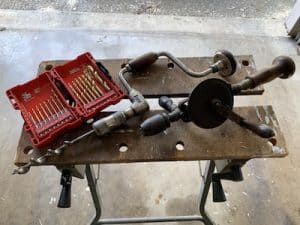
Hand Drill
A hand drill is what our grandparents used before modern power drills. They look and operate similar to crank-style egg beaters. They come in several different sizes and styles.
*Tip: When working with a hand drill, bits tend to slip inside the chuck. Because hand drills lack ratcheting or keyed chucks, it can be very difficult to properly secure bits. To help with this, use drill bits that have been designed to work with impact drivers. They have 1/4-inch hex shanks that are much easier to secure in less-sophisticated drill chucks.
Brace and Bit Set
While a hand drill works well to drill small holes quickly, a brace and bit set will allow you to drill larger and deeper holes. They also cut very clean, making them a good choice when doing work where appearance matters, like building furniture.
Crosscut Saw
Crosscut saws, as the name suggests, are designed to cut across (or perpendicular to) the grain of the wood. They come in several different sizes, each serving a different purpose.
Small crosscut saws are common items in many tool collections, being used to cut 2×4’s and other dimensional lumber to the proper length. Larger crosscut saws can be used to fell trees. Some are so large that they require two people to operate.
Because of their availability in varying sizes, it is a good idea to have multiple crosscut saws in your prepper tool kit. Small ones can replace a circular saw when power isn’t available. Large crosscut saws can be used to cut down trees and perform other tasks on large pieces of wood.
Rip Saw
Unlike a crosscut saw, a rip saw’s teeth are designed to cut in the same direction as the grain. Rip cuts tend to be longer in many cases than cross cuts, so be sure to use a straight edge or chalk line to lay an accurate reference line.
Specialty Tools
Depending on your interests or priorities, you may need specialty items in your prepper tool kit. For example, I enjoy working on my own guns. Because of this, I have several firearm-specific tools that wouldn’t be very useful for anything else.
An advantage of having specialty tools (and knowing how to use them) is that you will be able to perform jobs that other people won’t be able to. This could give you the ability to provide a valuable service during an emergency, which you may be able to utilize to secure food or protection for yourself and your loved ones.
Other specialty tools for preppers to include in their tool kit may be profession-specific. For examples, a surgeon may want to keep surgical tools around so they would be able to help others during an emergency.
Additional Information
Building a comprehensive prepper tool kit can turn into a huge project. If you would like further advice on the subject, the book Tools for Survival by James Wesley, Rawles is a very good source of information. While one person may not be able to acquire and learn how to use all of the tools discussed, it would be an excellent playbook if you wanted to equip your survival group and delegate areas of specialization between members. Mr. Rawles is one of the foremost experts in the prepping world and is the founder of SurvivalBlog.com
If you liked this article, take a look at these also:
How to Get Good Tools Cheap
Power Tools Every Prepper Needs
Tool Belt Setup
Power Tools and Prepping
What Every Prepper Needs to Know About Harbor Freight
Best Harbor Freight Free Items
DIY Laundry Folding Table
DIY Garden Tool Rack
How to Fix a Lawnmower that Won’t Start
How To Clear a Shower Clog
Milwaukee M18 Lantern and Floodlight Review
